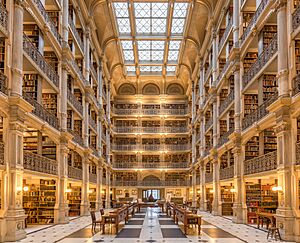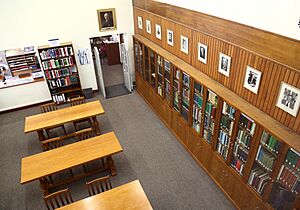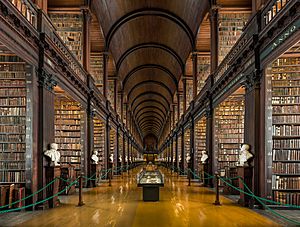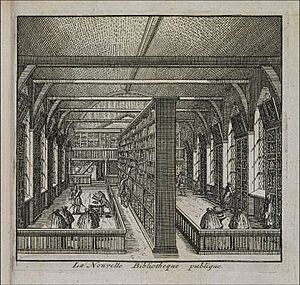Academic library facts for kids
An academic library is a special library found at a college or university. Its main job is to help students with their classes and teachers with their research. These libraries are filled with books, articles, and other materials that support the subjects taught at the school.
In the past, students would find required reading materials, called "reserves," as physical books or photocopies. Today, academic libraries offer much more. They provide access to huge online collections of e-books, research articles, and databases, which students can often use from anywhere with an internet connection.
Contents
What's Inside an Academic Library?
Librarians at universities can't collect every book ever published. Instead, they carefully choose books and resources that match what students and professors are studying. This is called "collection development." They think about the school's main subjects and what people need for their work.
Special Collections
Some libraries have "special collections," which are like treasure chests of rare and unique items. These aren't just regular books. They can include original letters from famous people, old maps, beautiful artwork, or handwritten manuscripts. These collections are often focused on a specific topic or person and are very valuable for research.
A Look Back in Time
Libraries have been part of learning for thousands of years. Some of the earliest large libraries were the famous Library of Alexandria in ancient Egypt and the library at Nalanda University in ancient India. The library at Nalanda was said to have so many manuscripts that it burned for months when it was destroyed.
Early Libraries in Europe and America
Many of Europe's oldest university libraries are still around today. The Bodleian Library at the University of Oxford opened in 1602, and Vilnius University Library in Lithuania opened even earlier in 1570.
In the early United States, the first colleges were mainly for training religious leaders. Their libraries were small and mostly had books about religion. Access was very limited. Often, only teachers could use the library, and it might only be open for a few hours a week! For example, in 1849, the library at Yale University was open 30 hours a week, while the one at Bowdoin College was only open for three.
Because the main libraries were so hard to use, students often started their own small libraries. They would form clubs, pay a fee, and buy books they could actually borrow and read.
Libraries Get Bigger and Better

In the late 1800s, things started to change. Librarians decided that making books easy to access was more important than just protecting them. Libraries got more funding and started to grow. In Canada, academic libraries grew much larger in the 1950s and 1960s as more people went to university and research became more important.
What Are University Libraries Like Today?

University libraries have changed a lot in the 21st century. While they still have plenty of physical books, they now focus heavily on digital resources and creating helpful spaces for students.
More Than Just Books
Today's academic libraries are gateways to a world of online information. Students can access:
- Online Databases: Huge collections of articles from academic journals.
- E-books: Digital versions of books that can be read on a computer or tablet.
- Digital Archives: Scanned copies of historical documents, photos, and newspapers.
Many libraries also lend out technology like laptops, video cameras, and calculators.
A Place to Work and Learn
Libraries are no longer just quiet places to read. They have been redesigned to be active learning hubs, sometimes called "learning commons." These spaces often include:
- Group Study Rooms: Where students can work on projects together.
- Silent Floors: For students who need complete quiet to concentrate.
- Help Desks: Where friendly librarians teach students how to find and use information for their assignments. This is called information literacy.
- Other Services: Many libraries also have writing centers for help with essays or tutoring services for tough subjects.
Giant Libraries Around the World
Academic libraries come in all sizes, but some are incredibly large.
- The Harvard Library at Harvard University is the largest academic library in the world. It holds over 20 million items, including books, manuscripts, and maps!
- The University of California has the largest academic library system in the world. It has about 41 million items spread across 100 libraries on its ten different campuses.
- For comparison, the Danish Royal Library in Denmark is even bigger. It's both a national library (for the whole country) and an academic library, and it has around 37 million items.
Images for kids
-
The Round Reading Room at the Maughan Library at King's College London.
-
The Old Library at Keio University in Tokyo, Japan.
-
The Law Library at the University of Michigan.
-
The inside of the National Library of Finland in Helsinki, which also serves the university.
See also
- Academic journal
- Internet search engines and libraries
- Library assessment
- Research library
- Research Libraries Group
- Research Libraries UK
- Shadow library
- Trends in library usage







